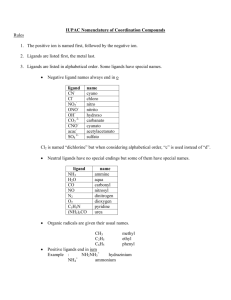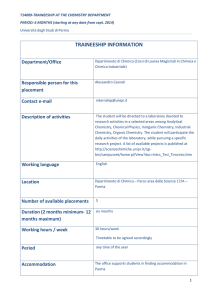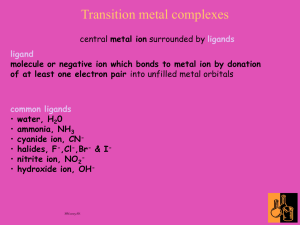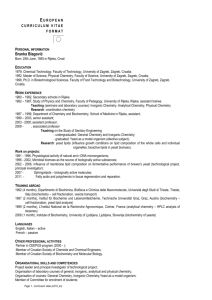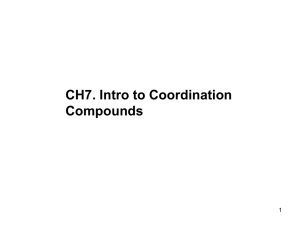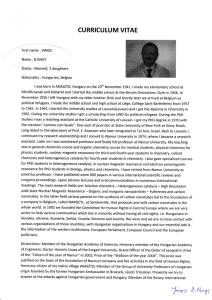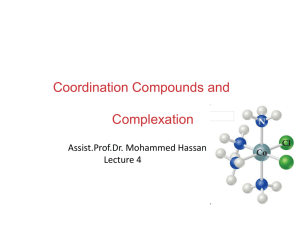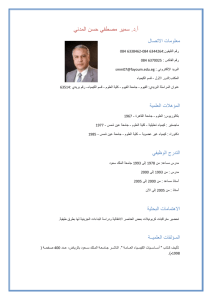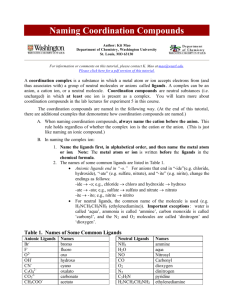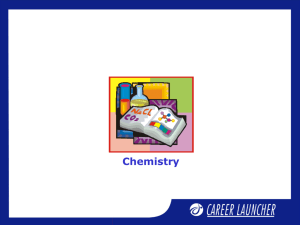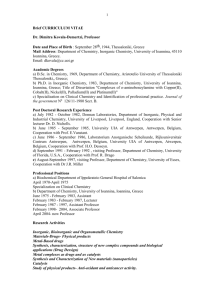CHEM 232 Inorganic Chemistry II (Spring 2004)
advertisement
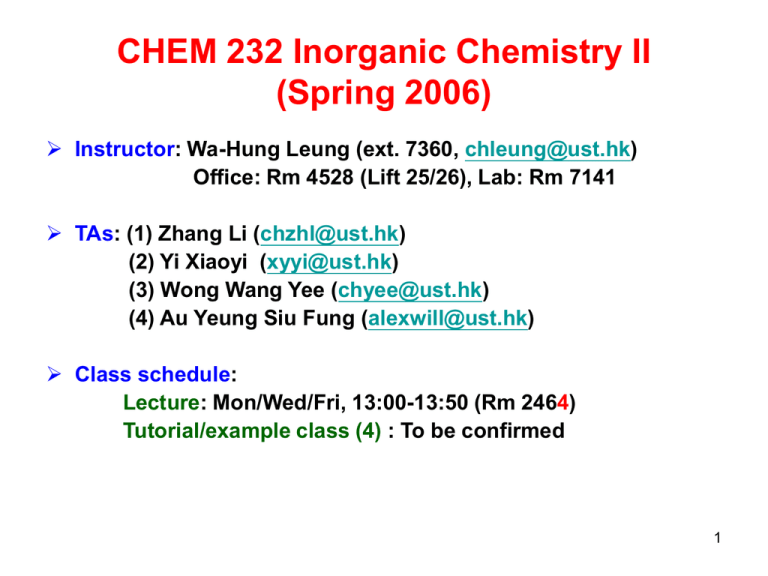
CHEM 232 Inorganic Chemistry II (Spring 2006) Instructor: Wa-Hung Leung (ext. 7360, chleung@ust.hk) Office: Rm 4528 (Lift 25/26), Lab: Rm 7141 TAs: (1) Zhang Li (chzhl@ust.hk) (2) Yi Xiaoyi (xyyi@ust.hk) (3) Wong Wang Yee (chyee@ust.hk) (4) Au Yeung Siu Fung (alexwill@ust.hk) Class schedule: Lecture: Mon/Wed/Fri, 13:00-13:50 (Rm 2464) Tutorial/example class (4) : To be confirmed 1 Course Contents 1. 2. 3. Coordination Chemistry Crystal field theory Spectral, magnetic, thermochemcial properties Coordination equilibria, chelate effect Organometallic chemistry 18 e rule, Carbonyl, olefin, cycloolefin compounds, Organometallic reactions, homogeneous catalysis Main group chemistry Hydride and alkyl compounds Element-element multiple bonds Inorganic rings and cages Silicates and aluminosilicates 2 Assessment scheme Attendance of lectures and Quizzes (4) Assignments (2) Mid-term exam (~ week 8/9) Final exam Tutorials (4) and others 8% 2x4% 38% 40% 6% • Check out a PRS handset! 3 Textbooks and references books Textbook: “Inorganic Chemistry” by C. E. Housecroft and A. G. Sharpe, Prentice Hall (1st ed., 2001; 2nd ed., 2005) Other suggested readings: Inorganic Chemistry, 3rd ed., by D. F. Shriver et al., OUP (1999). Basic Inorganic Chemistry, 3rd ed., by F. A. Cotton et al., Wiley (1995) Concepts and Models of Inorganic Chemistry, 3rd ed., by B. Douglas et al., Wiley (1994) Inorganic Chemistry, 3rd ed., by G.L. Miessler and D.A. Tarr, Prentice Hall (2004) 4 Websites Course homepage: http://webct.ust.hk Useful links • Department of Chemistry: http://www-chem.ust.hk/ • Textbook website: www.pearsoned.co.uk/housecroft • Periodic table: For example, http://www.webelements.com/ http://www.rsc.org/is/viselements.htm http://pubs.acs.org/cen/80th/elements.html Conduct in classroom: http://www.ust.hk/vpaao/conduct/con_classroom_Aug04.ppt 5 Coordination Chemistry • Ref.: Housecroft (Chap. 20), Shriver (Chap. 7) • Introduction: the metals and ligands • Crystal field theory: octahedral, tetrahedral, and square planar geometry • Spectrochemical series (strong/weak field ligands) • Electron configurations: LFSE, LS and HS config. • Spectral, magnetic and thermochemical properties • Coordination equilibria, chelate effect • M.O. diagram of ML6 6 Coordination compounds (metal complexes) Metal n+ L L M L nX L L L Counter anion Ligand Common geometry L L L M L L Tetrahedral L L L M L L Square planar M L L L Square pyramidal L L L L M L L M L L L Octahedral L L Trigonal bipyramidal 7 The metals Transition elements (http://www.rsc.org/is/viselements.htm) Elements with incomplete d shell (A) Position First/ second/ third row TMs Size decreases down a group Lanthanide contraction (filling of f orbitals) Sizes of 2nd row and 3rd row TMs are similar Ion Size/Å (CN = 6) Cr3+ 0.76 Mo3+ 0.83 Ru3+ Ir3+ 0.82 0.82 8 9 (B) Early/late TMs Early: on the LHS of the periodic table (e.g. Ti) Late: on the RHS of the periodic table (e.g. Pt) Usually, for metal complexes Early TM : high metal oxidation state, e.g. Ti(IV), V(V) (high valent); hard metal ions (binds to hard ligands) Late TM : low metal oxidation state, e.g. Pt(II), Au(I) (low valent); soft metal ions (binds to soft ligands) Why? 10 Atomic radius Ti Cu Atomic number 11 IE Ti Cu Atomic number 12 13 Ligands (A) Charge (formal charge) • Neutral (e.g. :CO, :PR3, :NH3) • Anionic (e.g. Cl-, O2-, CH3-) • Cationic (rare!) (e.g. NO+, C7H7+) (B) Hard/Soft properties Hard : period 1 donor (NH3, OH2) Soft : carbon (CO, CH3-, CH2=CH2) & period 2 donors (PR3, SR2) 14 (C) No. of donor atom unidentate NH3 ammonia or ammine N pyridine py bidentate NH2CH2CH2NH2 ethylenediamine (en) N N 2,2'-bipyridine bipy tridentate NH(CH2NH2)2 diethylenetriamine (dien) N N N 2,2':6',6"-terpyridine terpy Metal complexes with polydentate (chelating) ligands are more stable than those with unidentate analogues. Chelate effect 15 16 17 (ii) p acceptors (p acids) 18 Exercises Classify the following ligands as p donor, p acceptor, or s ligands • NMe3 • I• NO+ • CN• OH• H• CH3- 19 Nomenclature (1) Ligands in alphabetical order (3) Indicate O.N. of metal (in Roman no.: I, II, 0) (4) Indicate the no. of L and M (di, tri, tetra etc.). Also bis, tris, tetrakis (5) Anionic ligand o; e.g. Cl- (chloro), H- (hydrido), CN- (cyano) (6) Anionic complexes => ate e.g. Mn (manganate), Fe (ferrate), Cr (chromate) etc 20 (7) Add structural prefixes, e.g. cis/ trans, fac/ mer etc. L L M M L L L M L L M L L L trans cis fac mer Examples: K3[Mn(CN)6] Tripotassium hexacyanomanganate(III) Na2[Fe(CO)4] Disodium tetracarbonylferrate(-II) 21 Exercises Name the following compounds (1) [Mn2(CO)10], [Co2(CO)8] (2) [Ru(PPh3)4Cl2] (3) K2[Pt(CN)4] (4) [Cr(NH3)3(H2O)(OH)Cl][NO3] 22
